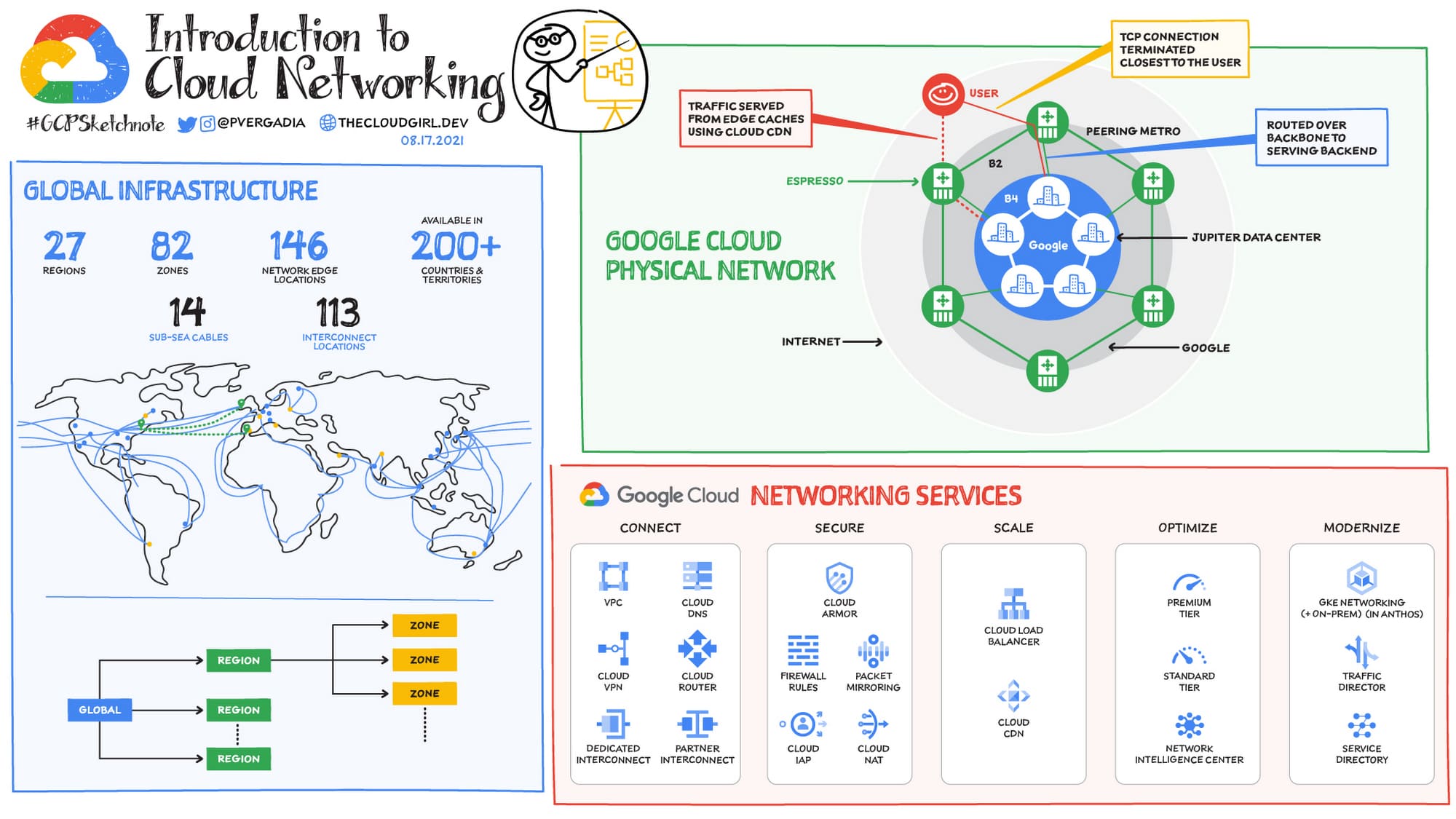Introduction
Google Cloud Platform (GCP) offers a robust and efficient environment for deploying and managing cloud applications. A key aspect of GCP is its networking capabilities, which are designed to be secure, scalable, and high-performing. In this article, we'll explore the essential components and concepts of GCP networking, using both in technical explanations and everyday analogies to make them accessible to a wide audience.
Understanding the Geographical Structure of GCP
Regions and Zones

Regions in GCP are specific geographical locations consisting of one or more zones. Zones are independent data centers within a region designed to be fault-tolerant and isolated from each other. This isolation ensures high availability of services by reducing the impact of zone-level failures. Deploying resources across multiple zones creates a resilient infrastructure that can withstand issues in a particular zone, similar to the way resources in traditional data centers are distributed across different locations for redundancy.
By deploying your resources across multiple zones within a region, you can ensure that if one zone experiences an outage, your services remain unaffected and available to your customers.
GCP's Global Network Infrastructure
Google's global network infrastructure powers services like Gmail and YouTube, providing fast and reliable connectivity for GCP customers around the world. This infrastructure consists of numerous points of presence (PoPs), edge caching locations, and thousands of miles of fiber optic cable. Google employs advanced routing techniques to optimize data transfer, ensuring low-latency communication between services.
By leveraging Google's global network infrastructure, you can ensure that your customers around the world experience fast and reliable access to your services, regardless of their location. This is a significant advantage compared to traditional networking, where global connectivity would typically require negotiating and maintaining relationships with multiple ISPs.
Secure and Scalable Networks in GCP
Virtual Private Cloud (VPC)
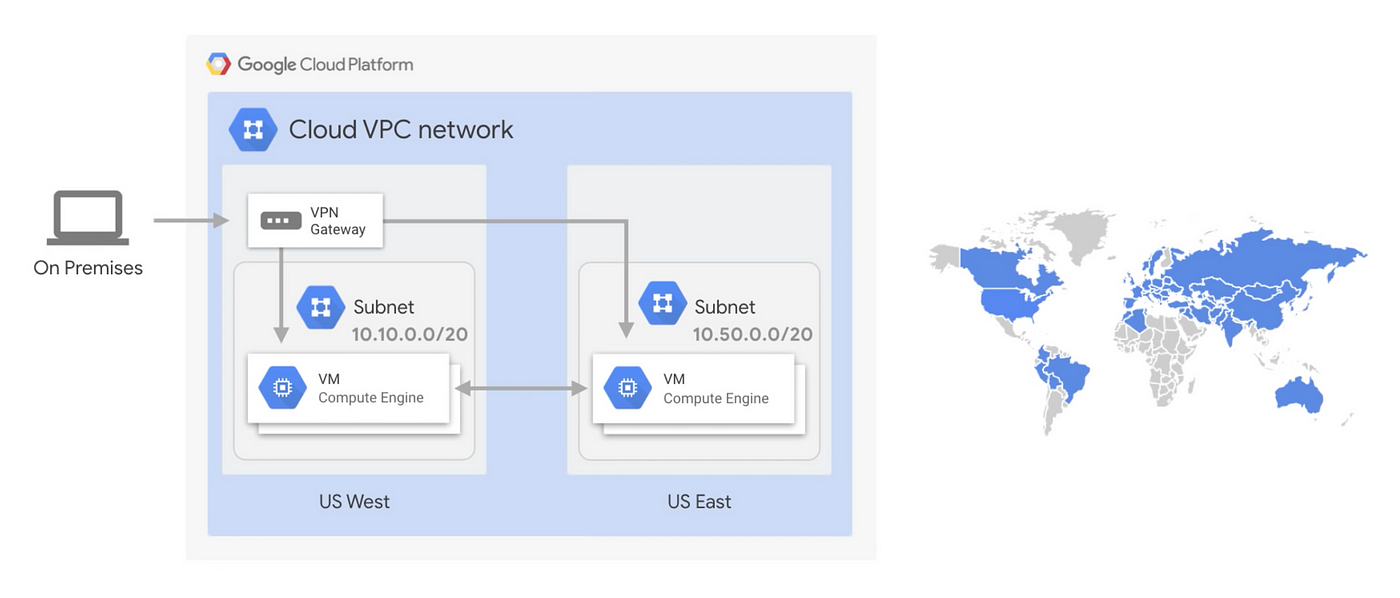
A VPC in GCP is a virtual network that provides a private, isolated environment for your cloud resources. It allows you to define your own IP address space, create subnets, configure routing tables, and set up firewall rules. VPCs are global resources, enabling you to deploy resources in different geographical locations while maintaining a unified network.
In contrast to AWS, where VPC networks are regional, GCP allows resources within the same VPC to reside anywhere in the world. This is possible due to an internal routing mechanism hidden from the user, making Google VPC networks more advanced than their equivalents on other cloud platforms. This is a significant improvement over traditional networking, where interconnecting resources across different geographical locations would involve complex routing and VPN configurations.
Subnets
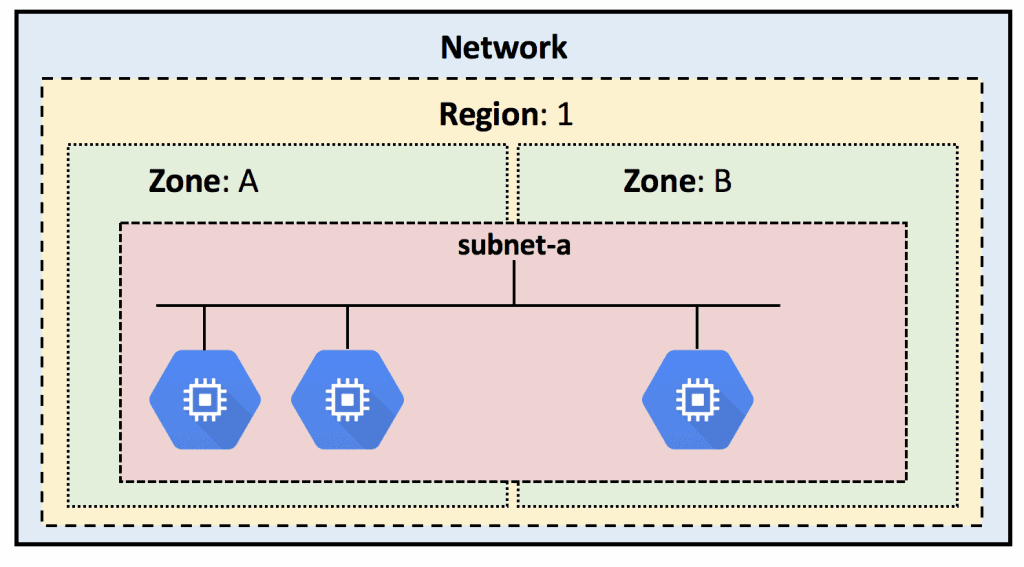
A subnet is a range of IP addresses within a VPC used to partition your network. Subnets help you organize and manage your resources, playing a crucial role in allocating private IP addresses to instances. Dividing your network into smaller subnets allows you to better control traffic, improve security, and simplify network management.
IP Address Management
GCP VPCs can be equated to autonomous systems (AS), which are networks of autonomous systems in the outside world. This means it's possible to have non-contiguous IP addresses inside the same VPC. For instance, the same VPC could have two subnets, one with a 10.x.x.x IP range and another with a 192.x.x.x range. This approach is useful for grouping and managing resources based on departments or other logical groupings, just like in a physical networking setup.
In GCP, subnets represent a hierarchical IP address range, and all resources in the same subnet must reside in the same region. However, the address ranges of different subnets cannot overlap. This approach ensures that resources are efficiently organized, and traffic between different subnets is managed effectively.
By deploying resources in separate subnets based on your requirements, you can efficiently manage access and traffic between these resources, ensuring optimal performance and security.
Routers and Network Connectivity
A router in GCP is a managed service that enables the exchange of traffic between different networks, including subnets within a VPC and external networks. Routers are essential for connecting your VPC to the internet, to Google services, or to other VPCs via VPC peering or VPN connections. In GCP, routers use dynamic routing with Border Gateway Protocol (BGP) to automatically learn and propagate routes, making it easy to adapt to changes in your network topology.
Compared to traditional networking, where static routing or manual BGP configuration is often required, GCP routers simplify network connectivity and management by automatically adapting to changes in the network infrastructure.
You can use GCP routers to connect your VPC to the internet, allowing your services to communicate with external resources and services. Additionally, you can establish VPC peering or VPN connections to link your VPC with other VPCs or on-premises networks, enabling seamless communication between different parts of your infrastructure.
Security and Compliance in GCP Networking
Network Address Translation (NAT)
Network Address Translation (NAT) is a technique used to enable instances within a subnet to access the internet without exposing their private IP addresses. In GCP, NAT is implemented using Cloud NAT, a managed service that works in conjunction with routers. This service allows instances within a subnet to share a public IP address when communicating with external resources, thereby preserving the security and privacy of their internal IP addresses.
Compared to traditional networking, where setting up NAT often requires manual configuration on routers or dedicated NAT devices, Cloud NAT simplifies the process and provides a scalable and managed solution.
By using Cloud NAT, you can ensure that your internal resources can access the internet securely without exposing their private IP addresses, maintaining the privacy and security of your infrastructure while enabling necessary communication with external services.
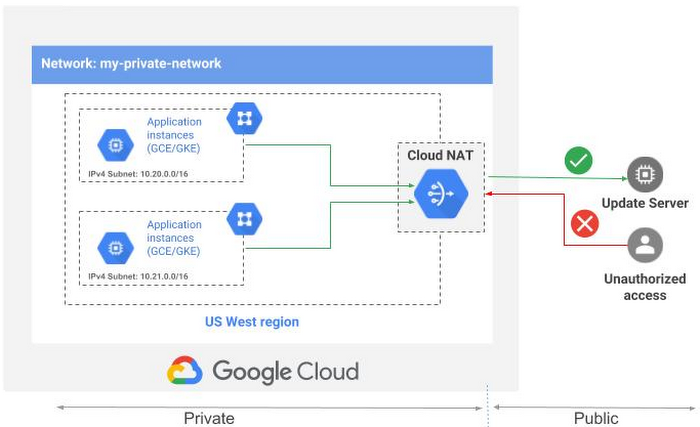
Firewall
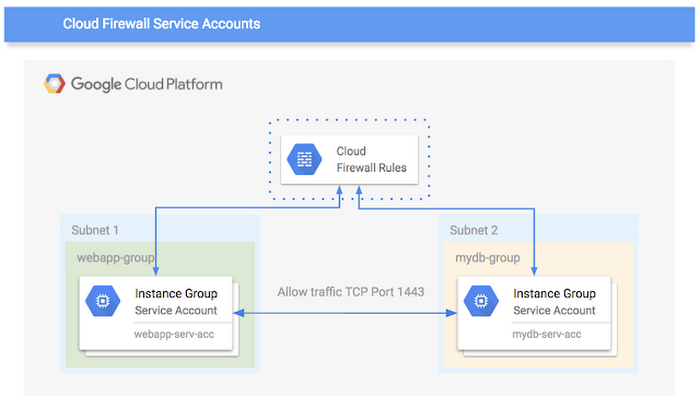
A firewall in GCP is a set of rules that govern the flow of traffic to and from instances within a VPC. These rules are defined using firewall rules, which specify the allowed or denied traffic based on factors such as IP addresses, protocols, and ports. Firewall rules are essential for securing your infrastructure by controlling inbound and outbound traffic and ensuring that only authorized communication is allowed.
In contrast to traditional networking, where firewalls are often physical devices requiring manual rule updates, GCP firewalls are integrated into the platform and can be easily managed using the console or APIs.
By creating and managing firewall rules within your VPC, you can protect your resources from unauthorized access and potential security threats. Defining specific rules for different services and subnets helps maintain a secure environment for your applications and data.
Conclusion
Google Cloud Platform's networking capabilities offer secure, scalable, and high-performance infrastructure for your cloud applications. By understanding and leveraging the features and concepts discussed in this article, you can build and manage your cloud infrastructure more efficiently, ensuring the best possible performance and security for your applications and data. With GCP's global network infrastructure, VPC, subnets, routers, NAT, and firewalls, you can create a reliable and secure environment to power your cloud-based applications and services, surpassing the limitations of traditional networking.
This table presents a high-level comparison of the various networking aspects in GCP and traditional networking. It highlights the differences in terms of geographical scope, network infrastructure, routing techniques, NAT implementation, and firewall management, demonstrating the advantages offered by GCP in terms of simplicity, scalability, and flexibility.
| Feature / Concept | GCP Networking | Traditional Networking |
|---|---|---|
| Regions and Zones | Global regions with zones | Data centers |
| Network Infrastructure | Google's global infrastructure | Multiple ISPs |
| VPC Scope | Global | Physical network |
| Subnets | Hierarchical IP ranges, regional | Network segments |
| Routers | Managed, dynamic routing | Manual/static routing |
| NAT | Cloud NAT (managed service) | Manual configuration |
| Firewall | Integrated with VPC | Physical devices |
About 8grams
We are a small DevOps Consulting Firm that has a mission to empower businesses with modern DevOps practices and technologies, enabling them to achieve digital transformation, improve efficiency, and drive growth.
Ready to transform your IT Operations and Software Development processes? Let's join forces and create innovative solutions that drive your business forward.
Subscribe to our newsletter for cutting-edge DevOps practices, tips, and insights delivered straight to your inbox!

